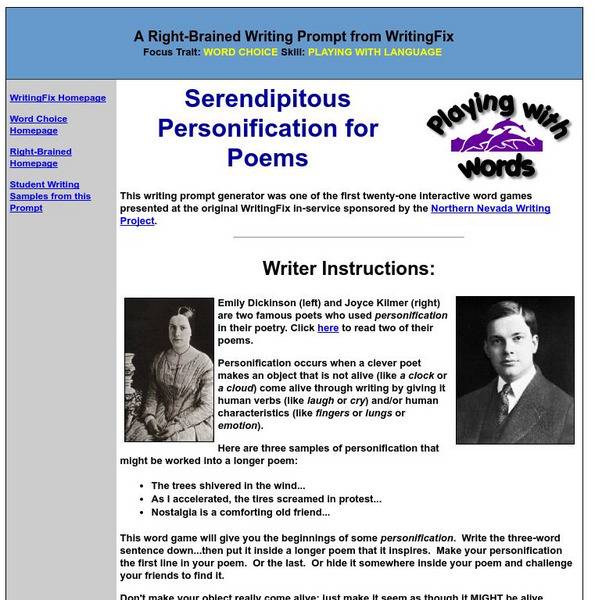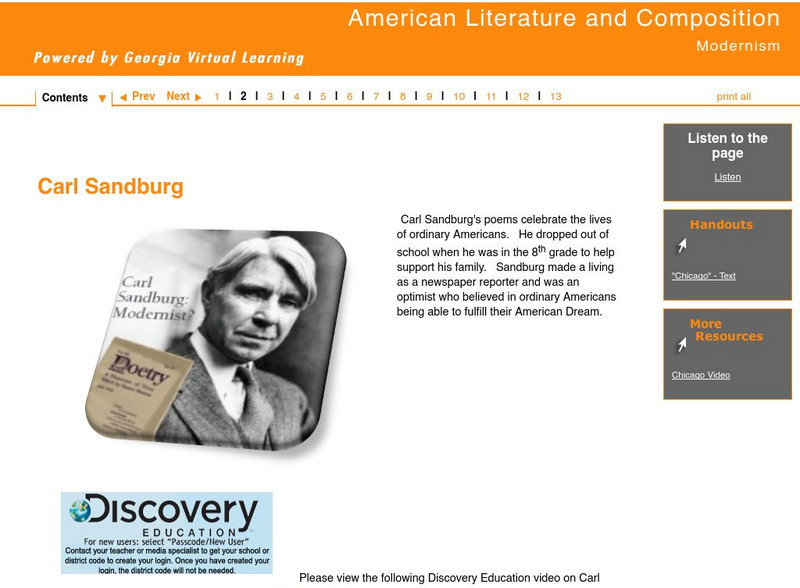Hi, what do you want to do?
Curated OER
Most Wanted Villians
Learners review the characteristics of various characters in fairytales. As a class, they review the story details and create a concept map using a software program. They create their own wanted poster of the villians in the fairytale to...
Curated OER
Embrace Space
Students use the internet to gather informatino about the solar system and space. In groups, they create a slideshow in which they use illustrations from the internet and include their own text. They complete the lesson by going on a...
Curated OER
Getting to Know You
Third graders explore different types of poetry and illustrate their own experiences through creating their own poem. In this getting to know you lesson plan, 3rd graders create and recite their poems with a self-portrait.
Curated OER
Figurative Language
Students put poetic interpretations back together to explain the poem. Starting with cliches, students learn what various phrases mean. They analyze words, phrases and levels of meaning.
Curated OER
Solid Waste
Students examine how to use their vocabulary, writing skills, and creative thinking to address environmental concerns in this unit. They write messages to using creative writing to address the issues of solid waste and recycling.
Curated OER
Safe from the Storm
Fourth graders read the poem "Snowbound" after brainstorming what a place of refuge is and why it's needed. They, in pairs, meet and write a list of ten attributes that describe a refuge. They write a paragraph describing the look, feel,...
Curated OER
Fifth Grade Literature: January
Fifth graders examine and analyze various poems by Edward Hersey Richards, Robert Frost, and Emily Dickinson. They explore similes, and write journal entry responses.
Curated OER
Black Bayou Lake Short Story
Tenth graders use Microsoft Word to create an original short story. The setting must be Black Bayou Lake National Wildlife Refuge. The characters must be animals found at Black Bayou Lake National Wildlife Refuge. The story must contain...
Curated OER
How To Identify Figurative Language
Young scholars investigate writing techniques by analyzing a chart. In this figurative language lesson, students define similes, metaphors and identify the difference between them and personification. Young scholars demonstrate their...
Curated OER
Journeying to Create
Show a video clip that descripes how taking a journey can change a person's outlook on life. Learners write a paragraph about a place that uses imagery and tone to create a specfic effect. They evaluate their journal entries as well.
Curated OER
Inspire the Imagination with a Poet Study of Shel Silverstein
Captivating prose opens wondrous doors to critical thinking and language development.
Curated OER
Figuring Out Frost
Fourth graders read "The Runaway" by Robert Frost and analyze it for its literal and symbolic meanings. They compare their personal experiences with the poet's suggestions about youthful attitudes and behaviors. Some nice worksheets are...
Curated OER
Legends of the Fifth
Fifth graders discover the difference between myths, legends, and folk tales. They summarize legends. They work together to dramatize legends and then create their own legend using the writing process. Handouts and worksheets are included.
Alabama Learning Exchange
Alex: Personification in Poetry
Students will explore the use of personification in published poetry and write a poem using personification. They will use clay animation to produce a short video of their poem.
ReadWriteThink
Read Write Think: Teaching Personification Through Poetry
This lesson plan examines the use of personification in the "great poets." Included in the lesson plan is an overview, practice, objectives, resources, preparation, and more.
Scholastic
Scholastic: Poetry Unzipped: Personification in Poetry [Pdf]
Two page, PDF format handout about Richard Wilber's poem "The Death of a Toad" used as an example of personification. Also includes a student-written explanation of the poem and a few discussion questions.
Other
Centre for Literacy in Primary Education: Poetryline: Poetic Forms and Devices
An excellent resource for learning about the different forms and devices used in poetry. Each item is linked to its own page which has examples of its use. Many of the pages have videos of authors reading their poems, and some have...
E Reading Worksheets
E Reading Worksheets: Figurative Language Poems With Questions
This learning module provides remediation and extra practice with identifying figurative language techniques in the context of poems. Nine different worksheets are available to help reinforce the concept of figurative language in poetry.
Writing Fix
Writing Fix: Serendipitous Personification for Poems
An explanation of personification and how it is used in poetry followed by a personification maker. Students push the buttons to create a personification and then write a poem that uses and expands on it.
Writing Fix
Writing Fix: The Poetry Lesson: Color Personification Poems
In this lesson, students will choose a color and write a poem. Students will use personification and speak from the point of view of the color. Then students will use watercolor paints to exemplify their poem about a color.
Writing Fix
Writing Fix: Color Personification Poems
In this lesson, Hailstones and Halibut Bones, a book written by Mary O'Neill and Red Sings, and From Treetops: a Year in Colors, a book by Joyce Sidman, are used as mentor texts. Students will brainstorm to collect different adjectives,...
Georgia Department of Education
Ga Virtual Learning:american Literature and Composition: Modernism:carl Sandburg
This lesson focuses on Carl Sanburg and his poem "Chicago." It includes biographical information, as well as links to the poem, a video of pictures of Chicago in the early 20th century, and a "Discovery Education" video on Carl Sandburg....
Love To Know Media
Your Dictionary: Literary Terms Lesson Plan
This is a lesson plan for teaching the seven literary terms used in poetry: simile, metaphor, alliteration, imagery, hyperbole, personification, and onomatopoeia.
National Endowment for the Humanities
Neh: Edsit Ement: Carl Sandburg's "Chicago": Bringing a Great City Alive
In this lesson students examine primary source documents including photographs, film, maps, and essays to learn about Chicago at the turn of the 20th century and Carl Sandburg's famous poem. After examining the poem's use of...




















![Scholastic: Poetry Unzipped: Personification in Poetry [Pdf] Unit Plan Scholastic: Poetry Unzipped: Personification in Poetry [Pdf] Unit Plan](https://content.lessonplanet.com/knovation/original/34502-bb3b353f9eb3e21dc4d528fca3f9487a.jpg?1661409330)






